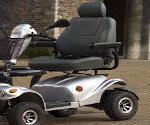So you want to know how the brakes on a rollator work? I had the same question when we first started shopping for walkers, and it’s actually pretty simple. In this article I’ll show you exactly how your rollator brakes work, how to apply them effectively, and how to adjust them to get the ideal braking pressure. Let’s get started!
The brakes on most rollators are called loop-lock brakes and they work in a similar way to a bicycle. The brakes are applied by gently pulling up on the brake levers located just below the handles of your walker. This uses a simple cable braking system to apply pressure to the brake pads on the rear wheels. You lock the brakes on most walkers by pushing down on the brake levers.
Keep reading for complete step-by-step instructions with images, learn advanced braking techniques, and discover the different types of brakes found on some rollators.

Using Your Rollator’s Brakes
[toc]
Where are the brakes on a rollator?
 The majority of rollators feature either “loop lock” or bicycle-style hand brakes which are located just under the handlebars on each side of the walker.
The majority of rollators feature either “loop lock” or bicycle-style hand brakes which are located just under the handlebars on each side of the walker.
Much less common are push-down brakes which are applied by simply pushing down on the handlebars of the walker. These type of brakes can help helpful for people with very weak hands who might not otherwise be able to apply the brakes of a regular rollator. However they can be difficult for many seniors to use because it can be tricky to find the right balance between leaning on the walker for support, and applying the brakes.
How to apply the brakes on a rollator
If your walker comes with the most common loop-lock or bicycle style brakes, then applying the brakes to slow down, stop, or prevent the walker from moving is as simple as pulling up on the brake levers. This will tug on the brake cable which will engage the wheel brake and the friction of the brake on the wheel is what makes the brake work.
The left and right brake levers apply the brakes independently to each side of the walker. Pull up on the left hand lever, and you apply the brake on the left wheel. Pull up on the right hand lever, and you apply the brake on the right wheel. To slow the walker down while moving in a straight line it is important to apply both brakes equally. If you use only one of the brakes, or use one much more so than the other, the walker will turn to the side with most of the brake force applied. (See “How to use the brakes to make tight turns” below to use this as an advanced steering technique.)
[su_divider top=”no” text=”Go to top” style=”default” divider_color=”#2BCDFC” link_color=”#F73F43″ size=”4″ margin=”14″]
How do you lock the wheels on a rollator?
Locking the wheels on a rollator — often referred to applying as the park brake — is accomplished on most models which feature standard loop-lock brakes by simply pushing down on the brake levers. This will lock the brakes in place and the wheels will not be able to move until you pull up on the brake levers again.
However, on some rollators such as the Volaris SMART All-Terrain, the brakes are locked using a dedicated park brake lever which is separate from the regular brake.

You can see the orange wheel lock brake lever on the Volaris in the image above, located just in front of the hand grips. The regular brakes are located below the hand grips.
[su_divider top=”no” text=”Go to top” style=”default” divider_color=”#2BCDFC” link_color=”#F73F43″ size=”4″ margin=”14″]
How to use the brakes to make tight turns
Because the brakes on a rollator work independently of each other, there is an advanced steering technique you can learn to help you make tight turns. If you would like to make a tight left turn then apply only the left-hand brake while keeping the right side un-braked. This will cause the walker to pivot sharply around the braked wheel, resulting in an extremely tight turn. Likewise, if you need to make a sharp right turn, apply only the right brake.
[su_divider top=”no” text=”Go to top” style=”default” divider_color=”#2BCDFC” link_color=”#F73F43″ size=”4″ margin=”14″]
How do you adjust the brakes on a rollator
The process for how to adjust rollator brakes is quite simple, and while there are some variations between different brands and walker models, the basic steps are similar.
- Find the brake adjustment screw located on the hand brake.
- Loosen the brake adjustment lock nut to allow the adjustment screw to move.
- Turn the brake adjustment screw counterclockwise to tighten the brakes, or clockwise loosen the brakes.
If your rollator came with a manual please refer to it for specific instructions for your walker.
[su_divider top=”no” text=”Go to top” style=”default” divider_color=”#2BCDFC” link_color=”#F73F43″ size=”4″ margin=”14″]
Adjusting the Vive Mobility Rollators Brakes
[su_youtube url=”https://www.youtube.com/watch?v=Zf6ZbmvwAO4″ responsive=”yes” autoplay=”no”]
To read our reviews of some Vive Mobility products and reviews please see:
[su_divider top=”no” text=”Go to top” style=”default” divider_color=”#2BCDFC” link_color=”#F73F43″ size=”4″ margin=”14″]
How to tighten brakes on a rollator
If you’ve adjusted the brakes as described above and you still need to get the brakes tighter, then the same steps can be applied at the other end of the brake cable.
- Find the brake adjustment screw located on the frame near the rear wheel.
- Loosen the brake adjustment lock nut to allow the adjustment screw to move.
- Turn the brake adjustment screw counterclockwise to tighten the brakes.
[su_divider top=”no” text=”Go to top” style=”default” divider_color=”#2BCDFC” link_color=”#F73F43″ size=”4″ margin=”14″]
How do you loosen a rollator brake?
To further loosen the rollator brakes to allow the unit to move more freely, adjust the unit as follows.
- Find the brake adjustment screw located on the frame near the rear wheel.
- Loosen the brake adjustment lock nut to allow the adjustment screw to move.
- Turn the brake adjustment screw clockwise to loosen the brakes.
[su_divider top=”no” text=”Go to top” style=”default” divider_color=”#2BCDFC” link_color=”#F73F43″ size=”4″ margin=”14″]
Could this article help a friend? Simply click on the envelope to share.




